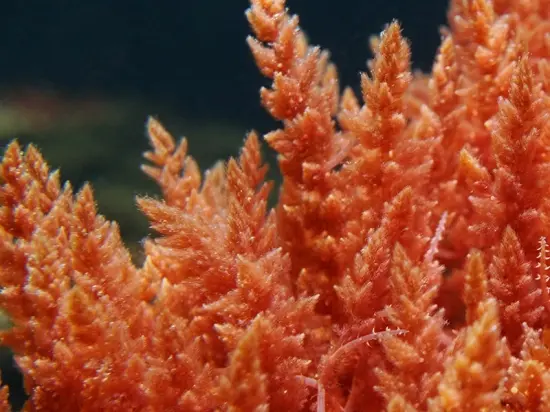
Asparagopsis armata
- Antioxidants[3]
- Antifungal[3]
- Antimicrobial[3, 4]
- Antiviral[3, 5]
On Demand weeks

Typical applications: Asparagopsis armata
Typical applications
The macroalga Asparagopsis armata belongs to the group of red algae and was originally native to southern waters, but due to globalization it is now also found in regions where it is considered invasive.
Asparagopsis armata is already established and used commercially, especially in the cosmetics industry. Just like other species of the genus Asparagopsis, it offers interesting possibilities to reduce methane emissions from cows by using it as part of animal feed[8, 9].
Due to its seasonality, the macroalga Asparagopsis armata is usually abundantly available from March to June.
This product is available in the form of Asparagopsis armata whole dried algae.
Typical applications in the cosmetics industry:
Asparagopsis armata harbors antioxidant and anti-inflammatory mechanisms that can be used as natural protective agents for the skin in cosmetics[3, 6].
In this regard, Asparagopsis armata can be incorporated into creams and lotions in the form of conditioners or moisturizers to soothe and revitalize the skin through the micronutrient profile[6].
Sources
- Asparagopsis armata Harvey 1855 - M.D. Guiry in Guiry, M.D. & Guiry, G.M. 01 February 2024. AlgaeBase. World-wide electronic publication, National University of Ireland, Galway. (https://www.algaebase.org/search/species/detail/?species_id=6)
- Asparagopsis armata - Wikipedia (https://en.wikipedia.org/wiki/Asparagopsis_armata)
- Ponte, José & Seca, Ana & Barreto, Maria Carmo. (2022). Asparagopsis Genus: What We Really Know About Its Biological Activities and Chemical Composition. Molecules. 27. 10.3390/molecules27061787. (https://www.researchgate.net/publication/359120361)
- Pinteus S, Alves C, Monteiro H, Araújo E, Horta A, Pedrosa R. Asparagopsis armata and Sphaerococcus coronopifolius as a natural source of antimicrobial compounds. World J Microbiol Biotechnol. 2015 Mar;31(3):445-51. doi: 10.1007/s11274-015-1797-2. Epub 2015 Jan 15. PMID: 25588525. (https://pubmed.ncbi.nlm.nih.gov/25588525/)
- Haslin C, Lahaye M, Pellegrini M, Chermann JC. In vitro anti-HIV activity of sulfated cell-wall polysaccharides from gametic, carposporic and tetrasporic stages of the Mediterranean red alga Asparagopsis armata. Planta Med. 2001 Jun;67(4):301-5. doi: 10.1055/s-2001-14330. PMID: 11458443. (https://pubmed.ncbi.nlm.nih.gov/11458443/)
- Ferreira MS, Resende DISP, Lobo JMS, Sousa E, Almeida IF. Marine Ingredients for Sensitive Skin: Market Overview. Mar Drugs. 2021 Aug 17;19(8):464. doi: 10.3390/md19080464. PMID: 34436303; PMCID: PMC8398991. (https://pubmed.ncbi.nlm.nih.gov/34436303/)
- Pereira AG, Fraga-Corral M, Garcia-Oliveira P, Lourenço-Lopes C, Carpena M, Prieto MA, Simal-Gandara J. The Use of Invasive Algae Species as a Source of Secondary Metabolites and Biological Activities: Spain as Case-Study. Mar Drugs. 2021 Mar 24;19(4):178. doi: 10.3390/md19040178. PMID: 33805184; PMCID: PMC8064379. (https://pubmed.ncbi.nlm.nih.gov/33805184/)
- George MM, Platts SV, Berry BA, Miller MF, Carlock AM, Horton TM, George MH. Effect of SeaFeed, a canola oil infused with Asparagopsis armata, on methane emissions, animal health, performance, and carcass characteristics of Angus feedlot cattle. Transl Anim Sci. 2024 Aug 3;8:txae116. doi: 10.1093/tas/txae116. PMID: 39192875; PMCID: PMC11347879. (https://pubmed.ncbi.nlm.nih.gov/39192875/)
- Wanapat M, Prachumchai R, Dagaew G, Matra M, Phupaboon S, Sommai S, Suriyapha C. Potential use of seaweed as a dietary supplement to mitigate enteric methane emission in ruminants. Sci Total Environ. 2024 Jun 25;931:173015. doi: 10.1016/j.scitotenv.2024.173015. Epub 2024 May 4. PMID: 38710388. (https://pubmed.ncbi.nlm.nih.gov/38710388/)

ALGANEX certificate system
Reply within twelve hours